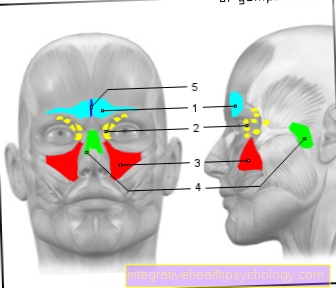Back training during pregnancy
introduction
Many women stop exercising soon after they become aware of their pregnancy for fear of harming the child. However, it is precisely this attitude that is counterproductive. Studies have found that pregnant women who continue to exercise have fewer physical complaints and a higher probability of a complication-free birth.
Read more about this under Pregnancy complications
Back training also supports posture and prevents back pain caused by pregnancy. In addition, training has a positive effect on the blood sugar level during pregnancy and the risk of being too heavy after pregnancy is greatly reduced.
Read more about this under Diabetes in Pregnancy

When should back training be started?
Women who do sport regularly do not need to take a break when they are pregnant, but can continue their training normally. This also includes back training. Anyone who did not exercise before pregnancy can start at any time. The motto here is: the earlier, the better.
Sports beginners should start with dosed loads and gradually increase step by step. When performing the back training session, women should always listen to their bodies and only perform the exercises and intensities that they are comfortable with. Back training can be started at any time, regardless of whether you are at the very beginning of your pregnancy or have been with it for a while. The training should feel good and high pulse values should be avoided at all costs.
You may also be interested in our new article: Exercise during pregnancy
The best exercises
From about the 16th week onwards, exercises that take place on the back or on the stomach should be avoided.
- An exercise that is also known from "normal" back training is the shoulder-foot bridge. The head, shoulder girdle, arms and feet rest on the floor. The pelvis is now lifted upwards so that the body from the shoulders to the feet has no contact with the floor and forms a bridge. It is important to keep tension and not to sag with your hips.
- Further exercises begin in the quadruped position, with the lower legs and hands on the floor. The back is in a horizontal position and the head in extension of the spine. Now you start to curve your back into a cat's hump, with your head moving between your upper arms. The movement is carried out slowly and up to an end point, held there briefly and then ended slowly and in a controlled manner in the starting position. The countermovement, in which you move your navel as far as possible from the four-footed position towards the ground and lean your head back a little, can also be carried out and thus go into a slightly hollow back. However, you should be careful with this exercise in the advanced month of pregnancy so as not to get too often and too strongly into a hollow back.
- The four-point prop is another exercise that is very similar to the four-legged stance. Your hands should be positioned just below your shoulders and your knees below your hips. The balls of the feet are on top and the shoulders should not be pulled up towards the ears. From this starting position, the knees are now raised a few millimeters, the stomach tensed and the position held for twenty to thirty seconds.
- The turtle or the diagonal stretch is an exercise that also begins in the four-footed position. Now right arm and left leg are stretched out at the same time so that only the left arm and right leg balance the body. The abdominal muscles should be tight and each side should be held for at least thirty seconds before switching.
- The tight row can be done with small dumbbells or with water bottles and is therefore also ideal for at home. In the starting position, the feet are hip-width apart, the upper body is tilted slightly forward with a straight back and the weights are in the hands. Now the arms are stretched diagonally forward and down and brought back close to the body. When moving backwards, the shoulder blades are drawn together and the chest is opened.
- An exercise that can only be performed with the help of an exercise ball strengthens the lower back extensors and thus prevents back pain. The starting position is standing with your back to a wall. The exercise ball is now clamped between the wall and tailbone and the ball begins to roll up and down. The upper body remains straight and is kept under tension. The legs alternate between an extended and a crouched position. The degree of the squat is determined individually by the trainee.
Up to what month should you train?
There are a few points to keep in mind when training your back. On the one hand, you should only train as long and often as your own well-being allows. In the event of pain or discomfort, the training should be stopped or the intensity should be reduced. In addition, care should be taken during pregnancy that from 4th / 5th month, ever according to individual condition, no more exercises in the prone or supine position should take place. The weight of the baby is now so high that internal organs could be compressed. This causes pain or the function of the respective organ can be impaired. Exercises that can take place while standing, kneeling or sitting may continue to be performed until the pregnant woman no longer feels comfortable with them, the doctor pronounces a ban or Complications arise.
General strength training during pregnancy
In principle, there is nothing wrong with strength training during pregnancy. It keeps the circulation going and, above all, stabilizing exercises for the trunk can have positive effects on childbirth and aftercare. The training makes it easier for women to cope with the higher body weight.
It is advisable to focus on training the back and trunk, as the additional weight of the child often causes back pain and tension. Targeted strength training for the back, trunk and pelvic floor can be used by pregnant women Make everyday life and childbirth much easier. Strength training can be carried out on machines, with small devices and other aids or using your own body weight. The woman should pay attention to the Weights moderate select and the Do not increase the load too high allow.
If the pregnant woman wants to train her abdominal muscles, care should be taken. It is important to distinguish between the oblique and the straight abdominal muscles. The straight abdominal muscles should no longer be trained from mid-pregnancyotherwise a crack can arise in the middle of the straight abdominal muscles. If the torso is rotated and the obliques trained, this cannot happen. However, these exercises should be done carefully and started with light weights.
Read more about this under Abs workouts during pregnancy
In general, when doing strength training during pregnancy, you shouldn't increase your weight if possible in order to avoid high loads. Regular moderate strength training strengthens the muscles, ligaments and support structures of the body, which means that the pregnant woman can better cope with the additional weight of the child.
General information on back training can be found at Back training





























.jpg)